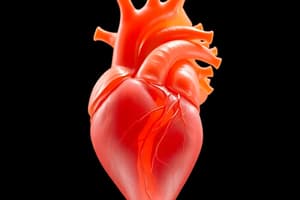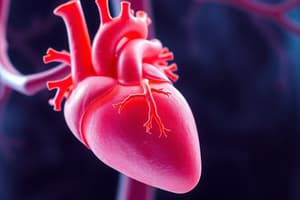Podcast
Questions and Answers
At what point during embryonic development does the first heartbeat occur?
At what point during embryonic development does the first heartbeat occur?
- Middle of the 4th Week
- 4th Week (correct)
- 22 to 23rd Day
- 18th Day
Which structure does the right horn of the sinus venosus NOT contribute to?
Which structure does the right horn of the sinus venosus NOT contribute to?
- Smooth posterior wall of the right atrium
- Forming the coronary sinus (correct)
- Oblique vein
- Rough anterior wall of the right atrium
What is NOT included in the four components of Tetralogy of Fallot?
What is NOT included in the four components of Tetralogy of Fallot?
- Overriding aorta
- Mitral valve prolapse (correct)
- Pulmonary stenosis
- Thickened right ventricle wall
What is the fate of the foramen ovale at birth?
What is the fate of the foramen ovale at birth?
The Bulbus cordis develops primarily during which weeks of embryogenesis?
The Bulbus cordis develops primarily during which weeks of embryogenesis?
Which statement about truncus arteriosus is correct?
Which statement about truncus arteriosus is correct?
What is the primary function of the foramen ovale in fetal circulation?
What is the primary function of the foramen ovale in fetal circulation?
Which of the following is NOT part of the embryonic heart development sequence?
Which of the following is NOT part of the embryonic heart development sequence?
Which of the following structures is associated with the development of the left atrium?
Which of the following structures is associated with the development of the left atrium?
Flashcards are hidden until you start studying
Study Notes
Heart Development Overview
- The heart tube grows faster than the pericardial sac, leading to five dilations and four constrictions: Sinus venosus, Common atrium, Common ventricle, Bulbus cordis, and Truncus arteriosus.
- The U-shaped heart tube forms due to the rapid growth of the bulbus cordis and ventricle, evolving into an S-shaped heart tube through looping.
Sinus Venosus Development
- By the fourth week of development, sinus venosus has right and left horns, each receiving three different veins:
- Cardinal vein from the fetal body.
- Vitelline vein from the yolk sac.
- Umbilical vein from the placenta.
- The right horn contributes to the formation of the smooth posterior part of the right atrium, while the left horn atrophies to become the coronary sinus.
Atria and Septum Formation
- The partitioning of the heart starts in the middle of the fourth week and completes by the end of the fifth week, involving:
- Atrioventricular canal
- Common atrium
- Common ventricle
- Truncus arteriosus and Bulbus cordis
- Endocardial cushions form in the AV canal, fusing to create the septum intermedium, dividing the canal into right and left canals, which separate the atrium from the ventricle.
Septum Primum and Ostium Primum
- Septum primum is a sickle-shaped growth from the common atrium's roof towards the endocardial cushions, partitioning it into right and left halves.
- The septum primum surrounds an opening called ostium primum, which allows oxygenated blood to flow from the right atrium to the left atrium.
- Ostium primum eventually diminishes and disappears as the septum primum fuses with the septum intermedium.
Septum Secundum Formation
- Formed above the septum primum, ostium secundum emerges as a result of small openings merging, leading to the formation of the foramen ovale.
- At birth, increased pressure in the left atrium presses the foramen ovale closed, becoming the fossa ovalis, with remnants of septum primum and secundum nearby.
Ventricular Division
- The interventricular septum differentiates into muscular and membranous parts, initiated by a median muscular ridge.
Common Cardiac Defects
- Atrial Septal Defects (ASD):
- Results from excessive resorption of septum primum, including conditions like patent foramen ovale.
- Ventricular Septal Defects (VSD):
- Linked to the absence of the membranous part of the interventricular septum; often associated with other cardiac defects.
- Tetralogy of Fallot:
- Comprised of pulmonary stenosis, right ventricular hypertrophy, VSD, and overriding aorta.
- Transposition of Great Arteries (TGA):
- Occurs due to abnormal rotation of the aorticopulmonary septum, leading to right ventricle connecting to aorta and left ventricle to pulmonary artery.
- Persistent Truncus Arteriosus:
- Resulting from failure of aorticopulmonary septum development, often co-occurring with VSD.
Key Developmental Milestones
- Heart primordium begins to develop by the 18th day.
- First heartbeat occurs between 22 to 33 days, with partitioning beginning in the middle of the 4th week and completed by the end of the 5th week.
Conclusion
- Understanding these stages in embryology of the heart is crucial for diagnosing and treating congenital heart defects.
Studying That Suits You
Use AI to generate personalized quizzes and flashcards to suit your learning preferences.



